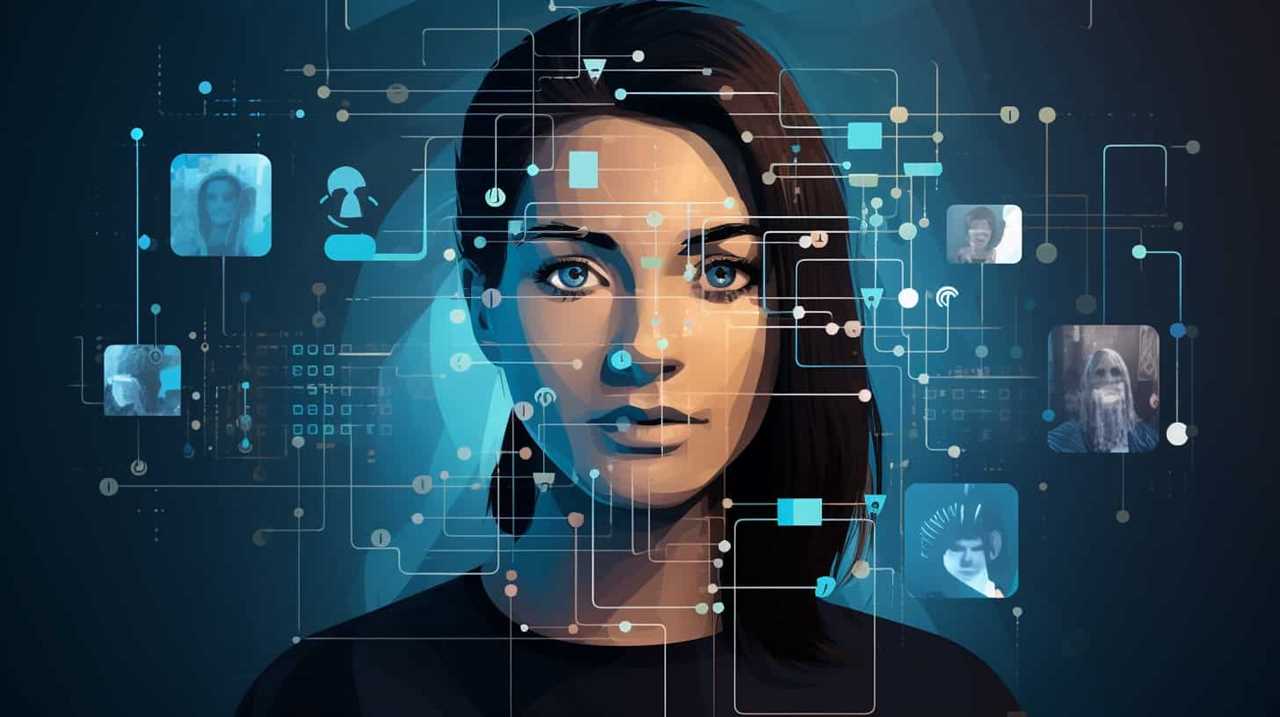As a fan of artificial intelligence, I have always felt that prioritizing AI security is essential for creating a safer future.
The potential of artificial intelligence is immense, but so are the vulnerabilities it brings.
In this article, we’ll delve into the importance of AI security and explore the measures we can take to protect against potential threats.
By understanding and implementing robust security measures, we can ensure the integrity of our data and privacy, paving the way for a secure AI-driven future.

Key Takeaways
- AI security is crucial for safeguarding sensitive data and information.
- AI systems are vulnerable to data breaches, unauthorized access, and manipulation of algorithms.
- Implementing AI security measures such as multi-factor authentication, regular software updates, and risk assessments is essential.
- AI security measures are necessary to protect data, uphold privacy rights, and maintain public trust in AI technologies.
Importance of AI Security
The importance of AI security can’t be overstated in today’s rapidly advancing technological landscape. As artificial intelligence becomes increasingly integrated into various sectors, the need for comprehensive risk assessment and protection against cybersecurity threats becomes paramount.
AI systems are vulnerable to a range of potential attacks, including data breaches, unauthorized access, and manipulation of algorithms. These threats can have far-reaching consequences, impacting not only the organizations that rely on AI but also the individuals whose personal information may be compromised.
To mitigate these risks, it’s crucial to implement robust security measures that encompass both proactive prevention and reactive incident response strategies. This involves continuous monitoring, vulnerability assessments, encryption protocols, and adherence to strict cybersecurity standards.
Understanding AI Vulnerabilities
One major vulnerability of AI systems is their susceptibility to various types of attacks. As AI technology becomes more widely adopted, the need for robust AI security measures becomes increasingly important.

AI vulnerability detection is crucial in identifying and mitigating potential AI security threats. AI systems can be vulnerable to attacks such as data poisoning, adversarial attacks, model stealing, and backdoor attacks.
Data poisoning involves injecting malicious data into the training set, which can lead to biased or compromised AI models. Adversarial attacks exploit vulnerabilities in AI algorithms by making subtle changes to input data, causing the system to make incorrect predictions.
Model stealing involves unauthorized access to AI models, which can result in intellectual property theft. Backdoor attacks can embed malicious code into AI models, allowing attackers to gain unauthorized access or control.
Understanding these vulnerabilities is the first step in developing effective AI security strategies to protect against potential threats.

Implementing AI Security Measures
Implementing robust AI security measures is essential for protecting against potential threats and vulnerabilities discussed earlier. To ensure the safety and integrity of AI systems, here are some best practices for AI security:
- Implement multi-factor authentication: Enforce strict access controls by requiring multiple forms of authentication, such as passwords, biometrics, and tokens, to prevent unauthorized access to AI systems.
- Regularly update and patch AI software: Stay updated with the latest security patches and fixes to address any vulnerabilities in the AI software, reducing the risk of exploitation.
- Conduct thorough risk assessments: Continuously assess potential risks and vulnerabilities in AI systems to identify and mitigate potential security issues before they’re exploited.
Impact of AI Security on Data and Privacy
As we delve into the impact of AI security on data and privacy, it becomes crucial to address the potential risks and vulnerabilities that AI systems may pose.
Data protection is a paramount concern when it comes to AI security. AI systems rely on vast amounts of data to make accurate predictions and decisions. However, this also means that there’s a higher risk of data breaches and unauthorized access to sensitive information.
Additionally, ethical implications arise when AI systems are used to process personal data. There’s a need for proper regulation and accountability to ensure that individuals’ privacy isn’t compromised.

Building a secure AI future requires implementing robust security measures and ethical guidelines to safeguard data and uphold privacy rights. By doing so, we can harness the power of AI while minimizing the potential risks it poses to data and privacy.
Moving forward, let’s explore the strategies for building a secure AI future.
Building a Secure AI Future
To ensure a safer future, I’ll now discuss how we can build a secure AI future.
As AI continues to advance, it brings with it a set of unique security challenges. Addressing these challenges is crucial to safeguard against potential threats and ethical implications.

Here are three key steps to building a secure AI future:
- Robust Authentication and Authorization: Implementing strong authentication and authorization mechanisms will help prevent unauthorized access to AI systems and ensure that only authorized individuals can interact with sensitive data.
- Secure Data Management: Employing robust encryption techniques and secure storage systems will protect the confidentiality and integrity of AI data, minimizing the risk of data breaches or tampering.
- Ethical Frameworks: Establishing comprehensive ethical frameworks for AI development and deployment will help address the ethical implications of AI security, ensuring that AI systems are designed and used responsibly.
Frequently Asked Questions
How Can AI Security Measures Be Implemented in a Way That Does Not Hinder the Performance or Efficiency of AI Systems?
Balancing performance and ensuring effectiveness in implementing AI security measures is crucial. By employing advanced algorithms and robust encryption techniques, potential vulnerabilities can be mitigated without compromising the efficiency of AI systems.
What Are Some Potential Challenges or Limitations in Implementing AI Security Measures?
Implementing AI security measures can be challenging due to data privacy concerns and regulatory challenges. It is crucial to balance security without hindering AI performance or efficiency, ensuring a safer future.
Are There Any Specific Industries or Sectors That Are More Vulnerable to AI Security Threats?
Certain industries, such as finance, healthcare, and transportation, are more vulnerable to AI security threats due to the sensitive nature of their data. Implementing AI security measures can impact performance and efficiency, but it is necessary for safeguarding against potential risks.

How Can Individuals Protect Their Personal Data and Privacy in an Increasingly Ai-Driven World?
To protect personal data and privacy in an AI-driven world, individuals must utilize data protection strategies and privacy enhancing technologies. Implementing encryption and regularly updating security measures are crucial steps.
What Are the Ethical Considerations That Need to Be Taken Into Account When Implementing AI Security Measures?
Ethical implications and legal considerations are crucial when implementing AI security measures. It is essential to address potential biases, ensure transparency, and protect individual rights to privacy and autonomy.
Conclusion
In conclusion, embracing AI security isn’t just a step towards a safer future, but a necessary one.
By understanding AI vulnerabilities and implementing appropriate security measures, we can protect our data and privacy in this rapidly evolving technological landscape.

Just as a fortress secures its inhabitants, AI security safeguards our digital world, shielding us from potential threats.
Let’s forge ahead, building a secure AI future that empowers us while preserving our fundamental rights.











